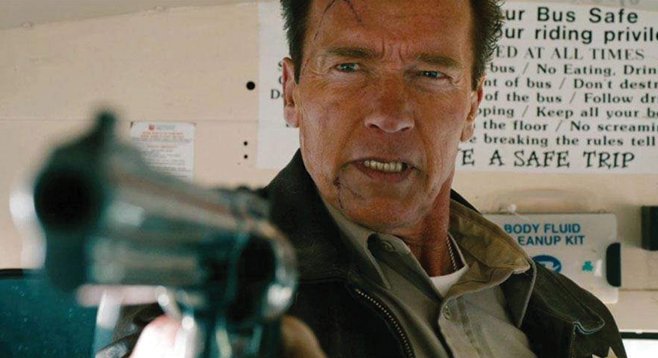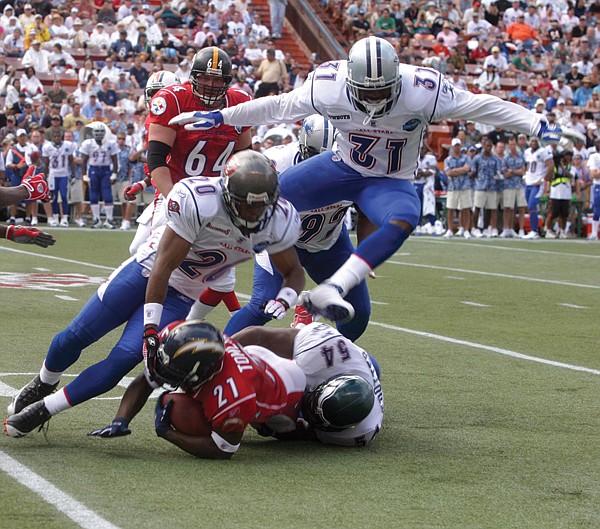 Facebook
Facebook
 X
X
 Instagram
Instagram
 TikTok
TikTok
 Youtube
Youtube

You turn on the TV to a football game. A 340-pound lineman smashes a 190-pound running back to the turf. The violent collision is replayed twice — along with the sound of the crash — as the play-by-play announcer lauds the lineman as “the National Football League’s fiercest tackler.” The color commentator exults, “This is smash-mouth football!” Next comes a movie ad: a grimacing guy (perhaps a former governor of California) sprays bullets from an automatic rifle at the bad guys, who fire back with assault weapons.
Next, you watch the news. Three sociology professors — reflecting on the Newtown massacre and football-related dementia — probe the roots of America’s violent culture. Nobody mentions the media.

But for decades, scholars have been studying the role of the media (particularly TV, movies, and video games) in worsening our violence/gun-obsessed society. However, not much research has been done on the role of television and video games in highlighting and celebrating football violence. Perhaps the fact that former Chargers linebacker and suicide victim Junior Seau had chronic traumatic encephalopathy, a brain disease caused by multiple hits, will awaken the nation — if not the National Football League.
A 2006 study by scholars at the University of Michigan and University of California Davis is often considered the bible on the media’s role in our violent society. The authors devoured many studies on the topic. Conclusion: “Media violence poses a threat to public health inasmuch as it leads to an increase in real-world violence and aggression,” both in the short and long term. Children are particularly vulnerable. A 1992 study indicated that by the time the average American child graduates from elementary school, he or she will have seen more than 8000 murders and 100,000 other violent acts (such as rapes or assaults) on network television.
The media industry generally asserts it reflects society, not shapes it. Although Hollywood officially deplores such events as the Sandy Hook Elementary School mass shooting, stars and producers insist there are not links between reel violence and real violence. “Keep the two separate,” says former California governor Arnold Schwarzenegger, whose new film, The Last Stand, is a Belshazzar’s Feast for lovers of guns and bloodshed.
K. Tim Wulfemeyer, professor at San Diego State’s School of Journalism and Media Studies, says “scientific research on this subject is mixed at best,” but it’s safe to say that media violence can reinforce tendencies toward such behavior that are already ingrained in a person. However, media blood-splattering cannot “cause average, normal people to actually commit violent acts.”
William F. Eadie of the San Diego State journalism/media department says, “There is a relationship between people watching media violence and acting aggressively, at least in the short term.” However, “Most people are able to distinguish between fantasy violence and actual violence.” But he warns that those who consume many hours of media a day may “have a distorted view of the world and have a higher chance of acting on these distortions.”
Dean Nelson, founder and director of the journalism program at Point Loma Nazarene University, points out that in court trials in which lawyers argue that a crime “is similar to what recently appeared in the movies or TV, [that argument] almost never ends up in a conviction. Jurors are not convinced there is a cause and effect” — that is, seeing a similar crime committed on TV did not motivate the person to go out and do the same.
As to the relationship of media violence and actual violence, Nelson says, “Correlation? Perhaps. Causation? Probably not.”
In retrospect, it is surprising that dementia and related mental diseases were not linked to football long ago. In the 1920s, doctors knew that repetitive brain trauma produced psychological afflictions in boxers. By the 1950s, many physicians wanted the sport banned. Boxers’ problems have had many names: punch-drunk syndrome, chronic boxer’s encephalopathy, boxer’s dementia, and the like. Among the prizefighters suspected of suffering head trauma-related dementia have been Joe Louis, Sugar Ray Robinson, Billy Conn, and Muhammad Ali (Parkinson’s syndrome probably caused by boxing).

As recently as 2009, the National Football League was insisting before an incredulous congressional committee that there was no connection between football head injuries and long-term brain trauma. But ESPN reported that in the 1990s and early 2000s, when the league was denying the connection between the sport and traumatic brain injuries, it was secretly paying off players who had suffered such woes.
Now, with more than 4000 players suing, the league brags that it is spending $30 million on head-injury research. This is an insult. Most owners are billionaires. The average team is worth $1.1 billion and enjoys $276 million in annual revenue. At the same time the National Football League boasts of the piddling $30 million it spends on research, it is contesting the suits of the 4000 players and still insisting it takes care of injured retired players.
There is a symbiotic relationship between the National Football League and television. Each team gets well over $100 million a year from the league’s deals with broadcasters. So does this cozy relationship explain why TV glorifies on-field carnage? “When young people see athletes being praised for aggressive (violent) behavior on the field — and in many cases being rewarded for such behavior — it’s not much of a stretch to believe that at least some people are going to try to emulate such behavior,” says Wulfemeyer. “When this happens, I guess you could say media-related praise for violent hits can contribute to cases of [chronic traumatic encephalopathy], crippling injuries, etc.”
Nelson is not sure that media celebration of butchery can be called a cause of the crippling diseases that afflict players, especially retired ones. However, continuous showing of violent action “is going to encourage other players to say, ‘I want to get on the highlight reel, too.’ It does encourage more violence.” ■
Contact Don Bauder at 619-546-8529


You turn on the TV to a football game. A 340-pound lineman smashes a 190-pound running back to the turf. The violent collision is replayed twice — along with the sound of the crash — as the play-by-play announcer lauds the lineman as “the National Football League’s fiercest tackler.” The color commentator exults, “This is smash-mouth football!” Next comes a movie ad: a grimacing guy (perhaps a former governor of California) sprays bullets from an automatic rifle at the bad guys, who fire back with assault weapons.
Next, you watch the news. Three sociology professors — reflecting on the Newtown massacre and football-related dementia — probe the roots of America’s violent culture. Nobody mentions the media.

But for decades, scholars have been studying the role of the media (particularly TV, movies, and video games) in worsening our violence/gun-obsessed society. However, not much research has been done on the role of television and video games in highlighting and celebrating football violence. Perhaps the fact that former Chargers linebacker and suicide victim Junior Seau had chronic traumatic encephalopathy, a brain disease caused by multiple hits, will awaken the nation — if not the National Football League.
A 2006 study by scholars at the University of Michigan and University of California Davis is often considered the bible on the media’s role in our violent society. The authors devoured many studies on the topic. Conclusion: “Media violence poses a threat to public health inasmuch as it leads to an increase in real-world violence and aggression,” both in the short and long term. Children are particularly vulnerable. A 1992 study indicated that by the time the average American child graduates from elementary school, he or she will have seen more than 8000 murders and 100,000 other violent acts (such as rapes or assaults) on network television.
The media industry generally asserts it reflects society, not shapes it. Although Hollywood officially deplores such events as the Sandy Hook Elementary School mass shooting, stars and producers insist there are not links between reel violence and real violence. “Keep the two separate,” says former California governor Arnold Schwarzenegger, whose new film, The Last Stand, is a Belshazzar’s Feast for lovers of guns and bloodshed.
K. Tim Wulfemeyer, professor at San Diego State’s School of Journalism and Media Studies, says “scientific research on this subject is mixed at best,” but it’s safe to say that media violence can reinforce tendencies toward such behavior that are already ingrained in a person. However, media blood-splattering cannot “cause average, normal people to actually commit violent acts.”
William F. Eadie of the San Diego State journalism/media department says, “There is a relationship between people watching media violence and acting aggressively, at least in the short term.” However, “Most people are able to distinguish between fantasy violence and actual violence.” But he warns that those who consume many hours of media a day may “have a distorted view of the world and have a higher chance of acting on these distortions.”
Dean Nelson, founder and director of the journalism program at Point Loma Nazarene University, points out that in court trials in which lawyers argue that a crime “is similar to what recently appeared in the movies or TV, [that argument] almost never ends up in a conviction. Jurors are not convinced there is a cause and effect” — that is, seeing a similar crime committed on TV did not motivate the person to go out and do the same.
As to the relationship of media violence and actual violence, Nelson says, “Correlation? Perhaps. Causation? Probably not.”
In retrospect, it is surprising that dementia and related mental diseases were not linked to football long ago. In the 1920s, doctors knew that repetitive brain trauma produced psychological afflictions in boxers. By the 1950s, many physicians wanted the sport banned. Boxers’ problems have had many names: punch-drunk syndrome, chronic boxer’s encephalopathy, boxer’s dementia, and the like. Among the prizefighters suspected of suffering head trauma-related dementia have been Joe Louis, Sugar Ray Robinson, Billy Conn, and Muhammad Ali (Parkinson’s syndrome probably caused by boxing).

As recently as 2009, the National Football League was insisting before an incredulous congressional committee that there was no connection between football head injuries and long-term brain trauma. But ESPN reported that in the 1990s and early 2000s, when the league was denying the connection between the sport and traumatic brain injuries, it was secretly paying off players who had suffered such woes.
Now, with more than 4000 players suing, the league brags that it is spending $30 million on head-injury research. This is an insult. Most owners are billionaires. The average team is worth $1.1 billion and enjoys $276 million in annual revenue. At the same time the National Football League boasts of the piddling $30 million it spends on research, it is contesting the suits of the 4000 players and still insisting it takes care of injured retired players.
There is a symbiotic relationship between the National Football League and television. Each team gets well over $100 million a year from the league’s deals with broadcasters. So does this cozy relationship explain why TV glorifies on-field carnage? “When young people see athletes being praised for aggressive (violent) behavior on the field — and in many cases being rewarded for such behavior — it’s not much of a stretch to believe that at least some people are going to try to emulate such behavior,” says Wulfemeyer. “When this happens, I guess you could say media-related praise for violent hits can contribute to cases of [chronic traumatic encephalopathy], crippling injuries, etc.”
Nelson is not sure that media celebration of butchery can be called a cause of the crippling diseases that afflict players, especially retired ones. However, continuous showing of violent action “is going to encourage other players to say, ‘I want to get on the highlight reel, too.’ It does encourage more violence.” ■
Contact Don Bauder at 619-546-8529
Comments